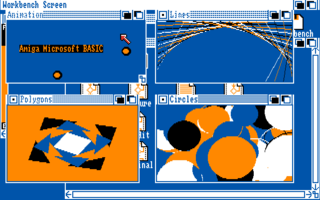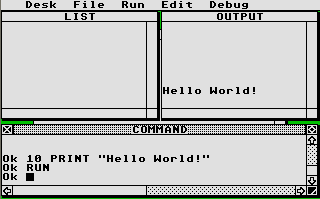
Amiga is a family of personal computers introduced by Commodore in 1985. The original model is one of a number of mid-1980s computers with 16- or 16/32-bit processors, 256 KB or more of RAM, mouse-based GUIs, and significantly improved graphics and audio compared to previous 8-bit systems. These systems include the Atari ST—released earlier the same year—as well as the Macintosh and Acorn Archimedes. Based on the Motorola 68000 microprocessor, the Amiga differs from its contemporaries through the inclusion of custom hardware to accelerate graphics and sound, including sprites and a blitter, and a pre-emptive multitasking operating system called AmigaOS.

The Atari ST is a line of personal computers from Atari Corporation and the successor to the Atari 8-bit family. The initial model, the Atari 520ST, had limited release in April–June 1985 and was widely available in July. It was the first personal computer with a bitmapped color GUI, using a version of Digital Research's GEM from February 1985. The Atari 1040ST, released in 1986 with 1 MB of RAM, was the first home computer with a cost-per-kilobyte of less than US$1.

AMOS BASIC is a dialect of the BASIC programming language for the Amiga computer. Following on from the successful STOS BASIC for the Atari ST, AMOS BASIC was written by François Lionet with Constantin Sotiropoulos and published by Europress Software in 1990.

Commodore International was an American home computer and electronics manufacturer founded by Jack Tramiel. Commodore International (CI), along with its subsidiary Commodore Business Machines (CBM), was a significant participant in the development of the home-computer industry in the 1970s, 1980s and early 1990s. The company developed and marketed the world's best-selling computer, the Commodore 64 (1982), and released its Amiga computer line in July 1985. With quarterly sales ending 1983 of $49 million, Commodore was one of the world's largest personal computer manufacturers.
A disk operating system (DOS) is a computer operating system that resides on and can use a disk storage device, such as a floppy disk, hard disk drive, or optical disc. A disk operating system provides a file system for organizing, reading, and writing files on the storage disk. Strictly, this definition does not include any other functionality, so it does not apply to more complex OSes, such as Microsoft Windows, and is more appropriately used only for older generations of operating systems.
The Motorola 68000 series is a family of 32-bit complex instruction set computer (CISC) microprocessors. During the 1980s and early 1990s, they were popular in personal computers and workstations and were the primary competitors of Intel's x86 microprocessors. They were best known as the processors used in the early Apple Macintosh, the Sharp X68000, the Commodore Amiga, the Sinclair QL, the Atari ST, the Sega Genesis, the Capcom System I (Arcade), the AT&T UNIX PC, the Tandy Model 16/16B/6000, the Sun Microsystems Sun-1, Sun-2 and Sun-3, the NeXT Computer, NeXTcube, NeXTstation, and NeXTcube Turbo, the Texas Instruments TI-89/TI-92 calculators, the Palm Pilot and the Space Shuttle. Although no modern desktop computers are based on processors in the 680x0 series, derivative processors are still widely used in embedded systems.
TRIPOS is a computer operating system. Development started in 1976 at the Computer Laboratory of Cambridge University and it was headed by Dr. Martin Richards. The first version appeared in January 1978 and it originally ran on a PDP-11. Later it was ported to the Computer Automation LSI4 and the Data General Nova. Work on a Motorola 68000 version started in 1981 at the University of Bath. MetaComCo acquired the rights to the 68000 version and continued development until TRIPOS was chosen by Commodore in March 1985 to form part of an operating system for their new Amiga computer; it was also used at Cambridge as part of the Cambridge Distributed Computing System.
The Atari Transputer Workstation is a workstation class computer released by Atari Corporation in the late 1980s, based on the INMOS transputer. It was introduced in 1987 as the Abaq, but the name was changed before sales began. Sales were almost non-existent, and the product was canceled after only a few hundred units had been produced.

AmigaBASIC is an interpreted BASIC programming language implementation for the Amiga, designed and written by Microsoft. AmigaBASIC shipped with AmigaOS versions 1.1 to 1.3. It succeeded MetaComCo's ABasiC, which was included in AmigaOS 1.0 and 1.1, and was superseded by ARexx, a REXX-style scripting language, from AmigaOS version 2.0 onwards.

Atari ST BASIC was the first dialect of BASIC that was produced for the Atari ST line of computers. This BASIC interpreter was bundled with all new STs in the early years of the ST's lifespan, and quickly became the standard BASIC for that platform. However, many users disliked it, and improved dialects of BASIC quickly came out to replace it.

Robert J. "RJ" Mical is an American computer programmer and hardware designer who has primarily worked in video games. He is best known for creating the user interface, Intuition, for Commodore's Amiga personal computer (1985), contributing to the design of the Amiga hardware, and co-designing, with Dave Needle, the Atari Lynx color handheld (1989) and the 3DO Interactive Multiplayer (1993).

Amiga Corporation was a United States computer company formed in the early 1980s as Hi-Toro. It is most famous for having developed the Amiga computer, code named Lorraine.
The Amiga is a family of home computers that were designed and sold by the Amiga Corporation from 1985 to 1994.
Touch Typist Typing Tutor is developed by Sector Software.
DTACK Grounded was a computer hobbyist newsletter published from July 1981 to September 1985 by Hal W. Hardenberg. Subtitled "The Journal of Simple 68000 Systems", the newsletter was dedicated to the proposition that the Motorola 68000 CPU could be used to build simple, fast computers. In 1981 this was a revolutionary idea. This was before 68000-based personal computers like the Sharp X68000, Macintosh, Amiga, and Atari ST had been created. In 1981 Motorola was marketing the 68000 solely as a CPU for Unix workstations. Hal believed that the 68000 could be used as a simple embedded microprocessor as well, and used the newsletter to explain how to do that.

Home computers were a class of microcomputers that entered the market in 1977 and became common during the 1980s. They were marketed to consumers as affordable and accessible computers that, for the first time, were intended for the use of a single nontechnical user. These computers were a distinct market segment that typically cost much less than business, scientific or engineering-oriented computers of the time such as those running CP/M or the IBM PC, and were generally less powerful in terms of memory and expandability. However, a home computer often had better graphics and sound than contemporary business computers. Their most common uses were playing video games, but they were also regularly used for word processing and programming.
This article deals with programming languages used in the Amiga line of computers, running the AmigaOS operating system and its derivatives AROS and MorphOS. It is a split of the main article Amiga software. See also related articles Amiga productivity software, Amiga music software, Amiga Internet and communications software and Amiga support and maintenance software for other information regarding software that runs on Amiga.

Sierra was the code name for a 16-bit/32-bit personal computer designed by the Sunnyvale Research Lab (SRL) of Atari, Inc. starting around 1983. The design was one of several new 16-bit computer systems proposing to use a new chipset from Atari Corporate Research.









